Tommaso Boccato
Towards Neural Foundation Models for Vision: Aligning EEG, MEG, and fMRI Representations for Decoding, Encoding, and Modality Conversion
Nov 14, 2024Abstract:This paper presents a novel approach towards creating a foundational model for aligning neural data and visual stimuli across multimodal representationsof brain activity by leveraging contrastive learning. We used electroencephalography (EEG), magnetoencephalography (MEG), and functional magnetic resonance imaging (fMRI) data. Our framework's capabilities are demonstrated through three key experiments: decoding visual information from neural data, encoding images into neural representations, and converting between neural modalities. The results highlight the model's ability to accurately capture semantic information across different brain imaging techniques, illustrating its potential in decoding, encoding, and modality conversion tasks.
Genetic Motifs as a Blueprint for Mismatch-Tolerant Neuromorphic Computing
Oct 25, 2024Abstract:Mixed-signal implementations of SNNs offer a promising solution to edge computing applications that require low-power and compact embedded processing systems. However, device mismatch in the analog circuits of these neuromorphic processors poses a significant challenge to the deployment of robust processing in these systems. Here we introduce a novel architectural solution inspired by biological development to address this issue. Specifically we propose to implement architectures that incorporate network motifs found in developed brains through a differentiable re-parameterization of weight matrices based on gene expression patterns and genetic rules. Thanks to the gradient descent optimization compatibility of the method proposed, we can apply the robustness of biological neural development to neuromorphic computing. To validate this approach we benchmark it using the Yin-Yang classification dataset, and compare its performance with that of standard multilayer perceptrons trained with state-of-the-art hardware-aware training method. Our results demonstrate that the proposed method mitigates mismatch-induced noise without requiring precise device mismatch measurements, effectively outperforming alternative hardware-aware techniques proposed in the literature, and providing a more general solution for improving the robustness of SNNs in neuromorphic hardware.
Optimizing Genetically-Driven Synaptogenesis
Feb 11, 2024Abstract:In this paper we introduce SynaptoGen, a novel framework that aims to bridge the gap between genetic manipulations and neuronal network behavior by simulating synaptogenesis and guiding the development of neuronal networks capable of solving predetermined computational tasks. Drawing inspiration from recent advancements in the field, we propose SynaptoGen as a bio-plausible approach to modeling synaptogenesis through differentiable functions. To validate SynaptoGen, we conduct a preliminary experiment using reinforcement learning as a benchmark learning framework, demonstrating its effectiveness in generating neuronal networks capable of solving the OpenAI Gym's Cart Pole task, compared to carefully designed baselines. The results highlight the potential of SynaptoGen to inspire further advancements in neuroscience and computational modeling, while also acknowledging the need for incorporating more realistic genetic rules and synaptic conductances in future research. Overall, SynaptoGen represents a promising avenue for exploring the intersection of genetics, neuroscience, and artificial intelligence.
Decoding visual brain representations from electroencephalography through Knowledge Distillation and latent diffusion models
Sep 08, 2023Abstract:Decoding visual representations from human brain activity has emerged as a thriving research domain, particularly in the context of brain-computer interfaces. Our study presents an innovative method that employs to classify and reconstruct images from the ImageNet dataset using electroencephalography (EEG) data from subjects that had viewed the images themselves (i.e. "brain decoding"). We analyzed EEG recordings from 6 participants, each exposed to 50 images spanning 40 unique semantic categories. These EEG readings were converted into spectrograms, which were then used to train a convolutional neural network (CNN), integrated with a knowledge distillation procedure based on a pre-trained Contrastive Language-Image Pre-Training (CLIP)-based image classification teacher network. This strategy allowed our model to attain a top-5 accuracy of 80%, significantly outperforming a standard CNN and various RNN-based benchmarks. Additionally, we incorporated an image reconstruction mechanism based on pre-trained latent diffusion models, which allowed us to generate an estimate of the images which had elicited EEG activity. Therefore, our architecture not only decodes images from neural activity but also offers a credible image reconstruction from EEG only, paving the way for e.g. swift, individualized feedback experiments. Our research represents a significant step forward in connecting neural signals with visual cognition.
Brain Captioning: Decoding human brain activity into images and text
May 19, 2023Abstract:Every day, the human brain processes an immense volume of visual information, relying on intricate neural mechanisms to perceive and interpret these stimuli. Recent breakthroughs in functional magnetic resonance imaging (fMRI) have enabled scientists to extract visual information from human brain activity patterns. In this study, we present an innovative method for decoding brain activity into meaningful images and captions, with a specific focus on brain captioning due to its enhanced flexibility as compared to brain decoding into images. Our approach takes advantage of cutting-edge image captioning models and incorporates a unique image reconstruction pipeline that utilizes latent diffusion models and depth estimation. We utilized the Natural Scenes Dataset, a comprehensive fMRI dataset from eight subjects who viewed images from the COCO dataset. We employed the Generative Image-to-text Transformer (GIT) as our backbone for captioning and propose a new image reconstruction pipeline based on latent diffusion models. The method involves training regularized linear regression models between brain activity and extracted features. Additionally, we incorporated depth maps from the ControlNet model to further guide the reconstruction process. We evaluate our methods using quantitative metrics for both generated captions and images. Our brain captioning approach outperforms existing methods, while our image reconstruction pipeline generates plausible images with improved spatial relationships. In conclusion, we demonstrate significant progress in brain decoding, showcasing the enormous potential of integrating vision and language to better understand human cognition. Our approach provides a flexible platform for future research, with potential applications in various fields, including neural art, style transfer, and portable devices.
Beyond Multilayer Perceptrons: Investigating Complex Topologies in Neural Networks
Mar 31, 2023Abstract:In this study, we explore the impact of network topology on the approximation capabilities of artificial neural networks (ANNs), with a particular focus on complex topologies. We propose a novel methodology for constructing complex ANNs based on various topologies, including Barab\'asi-Albert, Erd\H{o}s-R\'enyi, Watts-Strogatz, and multilayer perceptrons (MLPs). The constructed networks are evaluated on synthetic datasets generated from manifold learning generators, with varying levels of task difficulty and noise. Our findings reveal that complex topologies lead to superior performance in high-difficulty regimes compared to traditional MLPs. This performance advantage is attributed to the ability of complex networks to exploit the compositionality of the underlying target function. However, this benefit comes at the cost of increased forward-pass computation time and reduced robustness to graph damage. Additionally, we investigate the relationship between various topological attributes and model performance. Our analysis shows that no single attribute can account for the observed performance differences, suggesting that the influence of network topology on approximation capabilities may be more intricate than a simple correlation with individual topological attributes. Our study sheds light on the potential of complex topologies for enhancing the performance of ANNs and provides a foundation for future research exploring the interplay between multiple topological attributes and their impact on model performance.
Semantic Brain Decoding: from fMRI to conceptually similar image reconstruction of visual stimuli
Dec 13, 2022Abstract:Brain decoding is a field of computational neuroscience that uses measurable brain activity to infer mental states or internal representations of perceptual inputs. Therefore, we propose a novel approach to brain decoding that also relies on semantic and contextual similarity. We employ an fMRI dataset of natural image vision and create a deep learning decoding pipeline inspired by the existence of both bottom-up and top-down processes in human vision. We train a linear brain-to-feature model to map fMRI activity features to visual stimuli features, assuming that the brain projects visual information onto a space that is homeomorphic to the latent space represented by the last convolutional layer of a pretrained convolutional neural network, which typically collects a variety of semantic features that summarize and highlight similarities and differences between concepts. These features are then categorized in the latent space using a nearest-neighbor strategy, and the results are used to condition a generative latent diffusion model to create novel images. From fMRI data only, we produce reconstructions of visual stimuli that match the original content very well on a semantic level, surpassing the state of the art in previous literature. We evaluate our work and obtain good results using a quantitative semantic metric (the Wu-Palmer similarity metric over the WordNet lexicon, which had an average value of 0.57) and perform a human evaluation experiment that resulted in correct evaluation, according to the multiplicity of human criteria in evaluating image similarity, in over 80% of the test set.
BayesNetCNN: incorporating uncertainty in neural networks for image-based classification tasks
Sep 27, 2022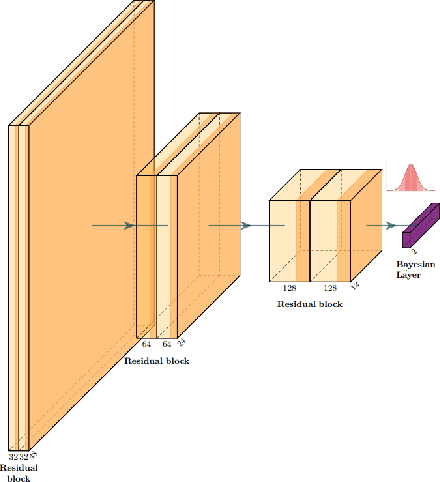
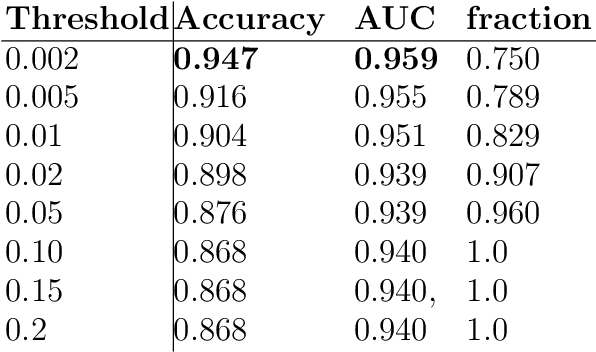
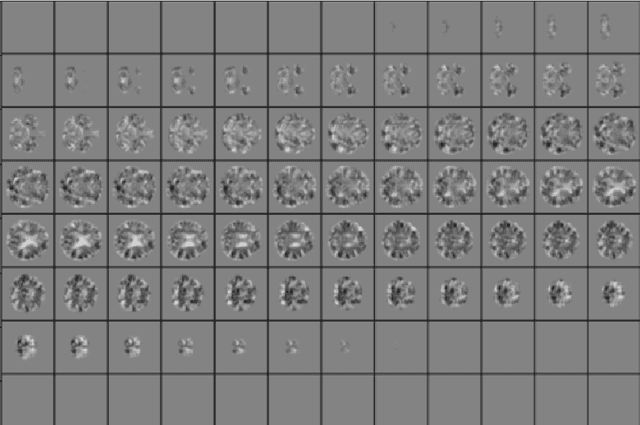
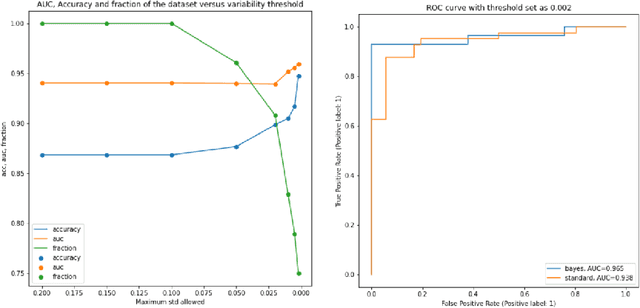
Abstract:The willingness to trust predictions formulated by automatic algorithms is key in a vast number of domains. However, a vast number of deep architectures are only able to formulate predictions without an associated uncertainty. In this paper, we propose a method to convert a standard neural network into a Bayesian neural network and estimate the variability of predictions by sampling different networks similar to the original one at each forward pass. We couple our methods with a tunable rejection-based approach that employs only the fraction of the dataset that the model is able to classify with an uncertainty below a user-set threshold. We test our model in a large cohort of brain images from Alzheimer's Disease patients, where we tackle discrimination of patients from healthy controls based on morphometric images only. We demonstrate how combining the estimated uncertainty with a rejection-based approach increases classification accuracy from 0.86 to 0.95 while retaining 75% of the test set. In addition, the model can select cases to be recommended for manual evaluation based on excessive uncertainty. We believe that being able to estimate the uncertainty of a prediction, along with tools that can modulate the behavior of the network to a degree of confidence that the user is informed about (and comfortable with) can represent a crucial step in the direction of user compliance and easier integration of deep learning tools into everyday tasks currently performed by human operators.
VAESim: A probabilistic approach for self-supervised prototype discovery
Sep 25, 2022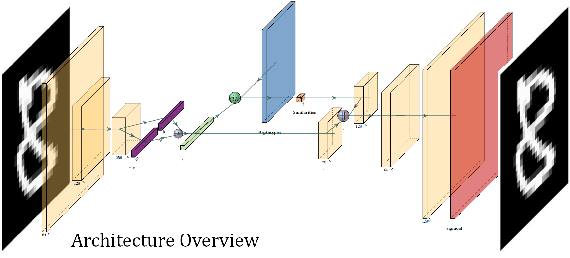
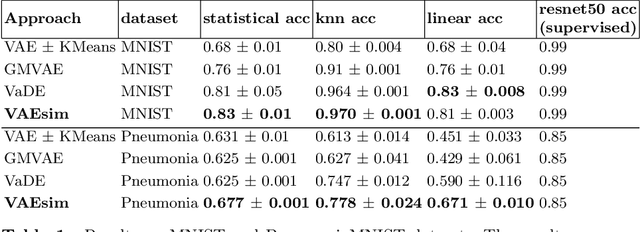
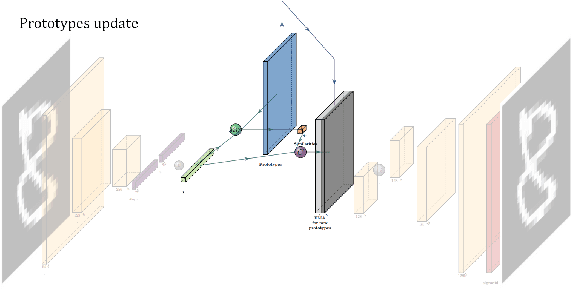
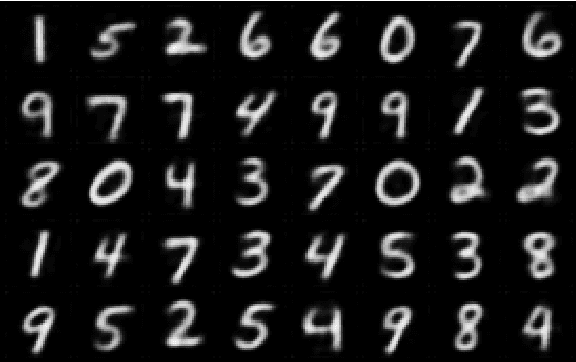
Abstract:In medicine, curated image datasets often employ discrete labels to describe what is known to be a continuous spectrum of healthy to pathological conditions, such as e.g. the Alzheimer's Disease Continuum or other areas where the image plays a pivotal point in diagnosis. We propose an architecture for image stratification based on a conditional variational autoencoder. Our framework, VAESim, leverages a continuous latent space to represent the continuum of disorders and finds clusters during training, which can then be used for image/patient stratification. The core of the method learns a set of prototypical vectors, each associated with a cluster. First, we perform a soft assignment of each data sample to the clusters. Then, we reconstruct the sample based on a similarity measure between the sample embedding and the prototypical vectors of the clusters. To update the prototypical embeddings, we use an exponential moving average of the most similar representations between actual prototypes and samples in the batch size. We test our approach on the MNIST-handwritten digit dataset and on a medical benchmark dataset called PneumoniaMNIST. We demonstrate that our method outperforms baselines in terms of kNN accuracy measured on a classification task against a standard VAE (up to 15% improvement in performance) in both datasets, and also performs at par with classification models trained in a fully supervised way. We also demonstrate how our model outperforms current, end-to-end models for unsupervised stratification.
Contrastive learning for unsupervised medical image clustering and reconstruction
Sep 24, 2022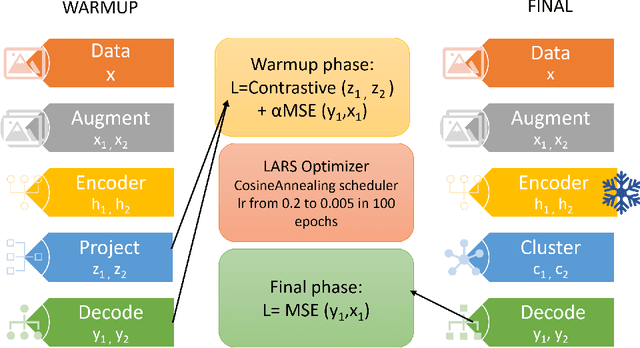
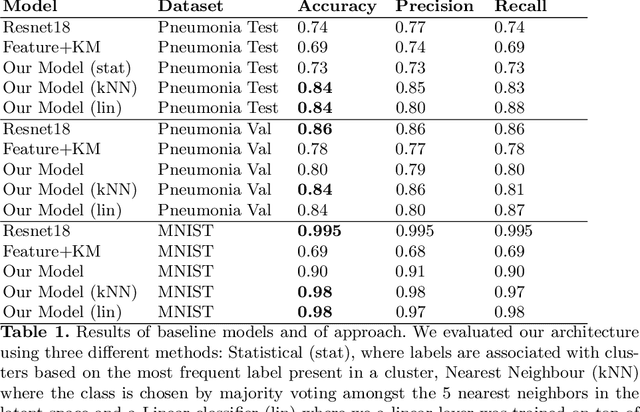
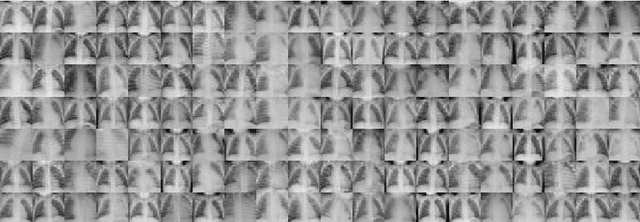
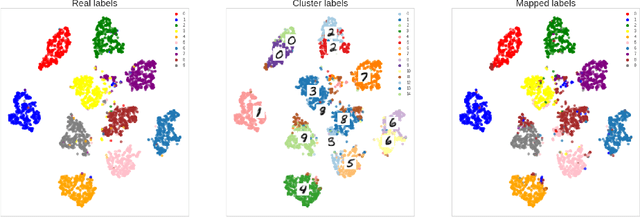
Abstract:The lack of large labeled medical imaging datasets, along with significant inter-individual variability compared to clinically established disease classes, poses significant challenges in exploiting medical imaging information in a precision medicine paradigm, where in principle dense patient-specific data can be employed to formulate individual predictions and/or stratify patients into finer-grained groups which may follow more homogeneous trajectories and therefore empower clinical trials. In order to efficiently explore the effective degrees of freedom underlying variability in medical images in an unsupervised manner, in this work we propose an unsupervised autoencoder framework which is augmented with a contrastive loss to encourage high separability in the latent space. The model is validated on (medical) benchmark datasets. As cluster labels are assigned to each example according to cluster assignments, we compare performance with a supervised transfer learning baseline. Our method achieves similar performance to the supervised architecture, indicating that separation in the latent space reproduces expert medical observer-assigned labels. The proposed method could be beneficial for patient stratification, exploring new subdivisions of larger classes or pathological continua or, due to its sampling abilities in a variation setting, data augmentation in medical image processing.
 Add to Chrome
Add to Chrome Add to Firefox
Add to Firefox Add to Edge
Add to Edge